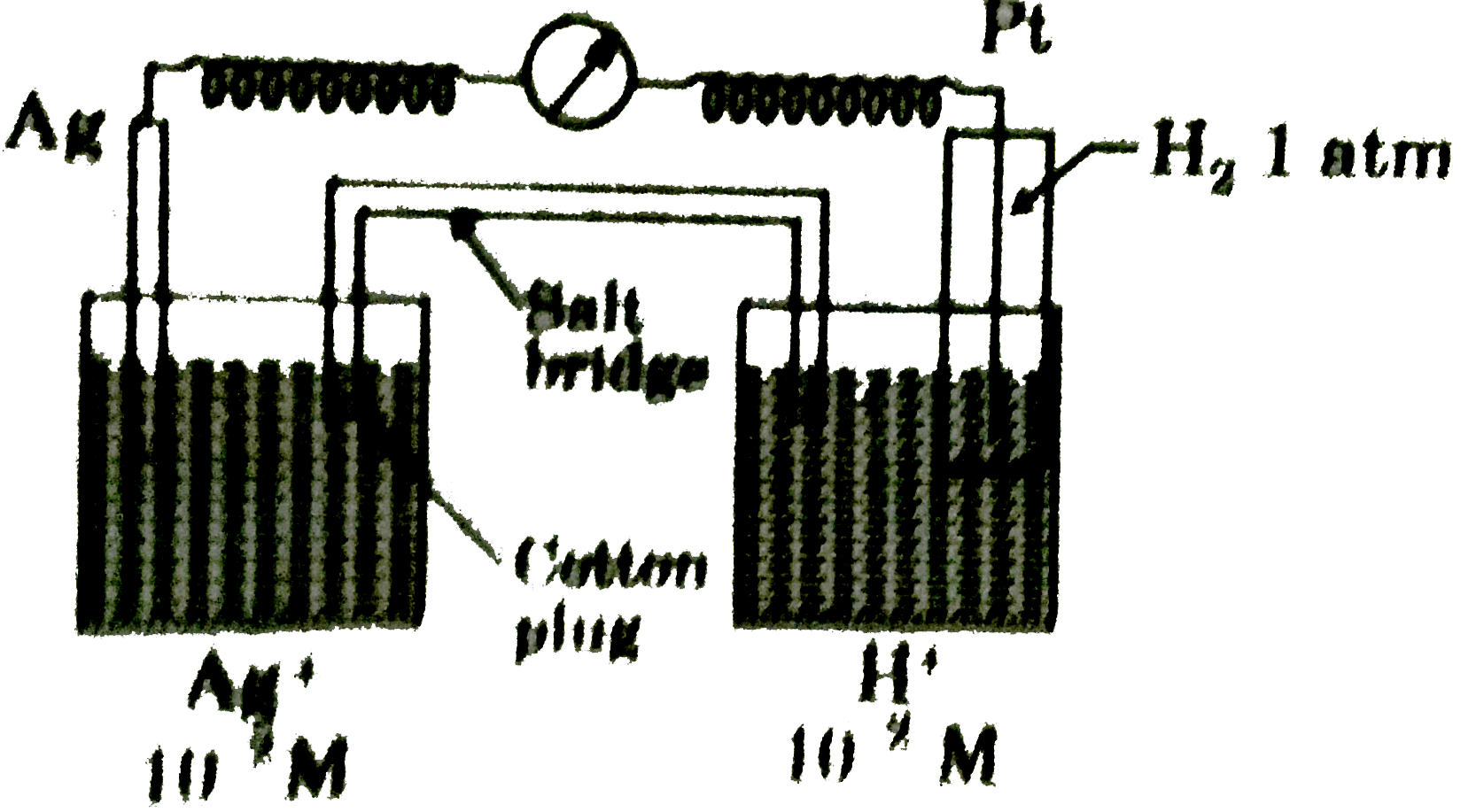Consider the cell ∣∣∣H2(Pt)1atm∣∣∣H3O+(aq)pH=5.5∣∣∣∣∣∣Ag+xM∣∣∣Ag . The measured EMF of the cell is 1.023V. What is the value of x?
E∘Ag+,Ag+0.799V.[T=25∘C]
2×10−2M
2×10−3M
1.5×10−3M
1.5×10−2M
The correct Answer is:A
To solve the problem, we need to determine the concentration of Ag⁺ ions (denoted as x) in the given electrochemical cell. Here are the steps to arrive at the solution:
Step 1: Write the half-reactions
The cell consists of two half-reactions: one at the anode (oxidation) and one at the cathode (reduction).
- Anode Reaction (Oxidation):
H2(g)→2H+(aq)+2e−
- Cathode Reaction (Reduction):
Ag+(aq)+e−→Ag(s)
Step 2: Combine the half-reactions
To balance the number of electrons transferred, we multiply the cathode reaction by 2:
2Ag+(aq)+2e−→2Ag(s)
Now, the overall balanced reaction is:
H2(g)+2Ag+(aq)→2H+(aq)+2Ag(s)
Step 3: Use the Nernst Equation
The Nernst equation relates the cell potential (E) to the standard electrode potentials and the concentrations of the reactants and products:
E=E∘−0.0591nlogQ
Where:
- E = cell potential (1.023 V)
- E∘ = standard cell potential
- n = number of moles of electrons transferred (2 in this case)
- Q = reaction quotient
Step 4: Calculate the standard cell potential
The standard cell potential E∘ can be calculated as follows:
E∘=E∘cathode−E∘anode
Given:
- E∘Ag+/Ag=0.799V
- E∘H+/H2=0V (standard hydrogen electrode)
Thus,
E∘=0.799V−0V=0.799V
Step 5: Substitute values into the Nernst equation
Now we can substitute the values into the Nernst equation:
1.023=0.799−0.05912log((H+)2(Ag+)2)
Step 6: Calculate (H⁺) from pH
Given that pH = 5.5, we can calculate the concentration of H+:
(H+)=10−pH=10−5.5=3.16×10−6M
Step 7: Substitute (H⁺) into the equation
Substituting (H+) into the Nernst equation:
1.023=0.799−0.05912log((3.16×10−6)2(Ag+)2)
Step 8: Simplify the equation
Rearranging gives:
1.023−0.799=−0.05912log((3.16×10−6)2(Ag+)2)
0.224=−0.05912log((3.16×10−6)2(Ag+)2)
Step 9: Solve for (Ag⁺)
Now we can solve for (Ag+):
log((3.16×10−6)2(Ag+)2)=−0.224×20.0591
Calculating the right-hand side gives:
log((3.16×10−6)2(Ag+)2)=−7.57
Taking the antilog:
(3.16×10−6)2(Ag+)2=10−7.57
(Ag+)2=(3.16×10−6)210−7.57
Calculating this gives:
(Ag+)2=9.98×10−8
(Ag+)=√9.98×10−8≈3.16×10−4M
Conclusion
Thus, the value of x (the concentration of Ag+) is approximately 0.0316M.
---
The cell consists of two half-reactions: one at the anode (oxidation) and one at the cathode (reduction).
H2(g)→2H+(aq)+2e−
Ag+(aq)+e−→Ag(s)
To balance the number of electrons transferred, we multiply the cathode reaction by 2:
H2(g)+2Ag+(aq)→2H+(aq)+2Ag(s)
The Nernst equation relates the cell potential (E) to the standard electrode potentials and the concentrations of the reactants and products:
- E = cell potential (1.023 V)
- E∘ = standard cell potential
- n = number of moles of electrons transferred (2 in this case)
- Q = reaction quotient
The standard cell potential E∘ can be calculated as follows:
E∘=E∘cathode−E∘anode
Given:
- E∘Ag+/Ag=0.799V
- E∘H+/H2=0V (standard hydrogen electrode)
E∘=0.799V−0V=0.799V
Now we can substitute the values into the Nernst equation:
1.023=0.799−0.05912log((H+)2(Ag+)2)
Given that pH = 5.5, we can calculate the concentration of H+:
(H+)=10−pH=10−5.5=3.16×10−6M
Substituting (H+) into the Nernst equation:
1.023=0.799−0.05912log((3.16×10−6)2(Ag+)2)
Rearranging gives:
1.023−0.799=−0.05912log((3.16×10−6)2(Ag+)2)
0.224=−0.05912log((3.16×10−6)2(Ag+)2)
Now we can solve for (Ag+):
log((3.16×10−6)2(Ag+)2)=−0.224×20.0591
Calculating the right-hand side gives:
log((3.16×10−6)2(Ag+)2)=−7.57
Taking the antilog:
(3.16×10−6)2(Ag+)2=10−7.57
(Ag+)2=(3.16×10−6)210−7.57
Calculating this gives:
(Ag+)2=9.98×10−8
(Ag+)=√9.98×10−8≈3.16×10−4M
Thus, the value of x (the concentration of Ag+) is approximately 0.0316M.
Topper's Solved these Questions
- BOOK - ALLENCHAPTER - ELECTROCHEMISTRYEXERCISE - EXERCISE-0324videos
ELECTROCHEMISTRY
- BOOK - ALLENCHAPTER - ELECTROCHEMISTRYEXERCISE - EXERCISE-04 [A]56videos
ELECTROCHEMISTRY
- BOOK - ALLENCHAPTER - ELECTROCHEMISTRYEXERCISE - Part (II) EXERCISE-0144videos
ELECTROCHEMISTRY
- BOOK - ALLENCHAPTER - CHEMISTRY AT A GLANCEEXERCISE - ORGANIC CHEMISTRY483videos
CHEMISTRY AT A GLANCE
- BOOK - ALLENCHAPTER - HYDROCARBONEXERCISE - MCQ15videos
HYDROCARBON
Similar Questions
The emf of the cell, Pt|H2(1atm)|H+(0.1M,30mL)∣∣Ag+(0.8M)Ag is 0.9V. Calculate the emf when 40mL of 0.05MNaOH is added.
View SolutionVoltage of the cell Pt,H2(1atm)∣∣HOCN(1.3×10−3M)∣∣∣∣Ag+(0.8M)∣∣Ag(s) is 0.982V. Calculate the Ka for HOCN, neglect [H+] because of oxidation of H2(g)
Ag++e−→Ag(s)=0.8VView Solution
Knowledge Check
- Question 1 - Select One
Calculate emf of given cell at 25∘C:

[Given: E∘Ag+/Ag)=0.80V]A+0.80VB0.12 VC−0.178VD1.04 V - Question 2 - Select One
The E∘(cell) value for Pt,H2∣∣H+∣∣∣∣Ag+∣∣Ag is E∘(Ag/Ag+)=−0.799V)
A0.0 VB0.399 VC−0.799VD0.799 V - Question 3 - Select One
The measured voltage of the cell, Pt(s)|H2(1.0atm)|H+(aq)∣∣∣Ag+(1.0M)∣∣Ag(s) is 1.02V at 25∘C . Given E∘cell is 0.80 V, calculate the pH of the solution .
A1.86B1.69C3.73D7.43
Calcualte the EMF of the cell at 298K
Pt|H2(1atm)|NaOH(xM),
NaCl(xM)|AgCl(s)|Ag
E∘Cl−|AgCl|Ag = +0.222VView SolutionAn alloy of Pb-Ag weighing 1.08g was dissolved in dilute HNO3 and the volume made to 100 mL.A ? Silver electrode was dipped in the solution and the emf of the cell dipped in the solution and the emf of the cell set-up as Pt(s),H2(g)∣∣H+(1M)∣∣∣∣Ag+(aq.)∣∣Ag(s) was 0.62V . If E∘cell is 0.80V, what is the percentage of Ag in the alloy ? (At 25∘C,RT/F=0.06)
View SolutionAn alloy of Pb-Ag weighing 1.08 g was dissolved in dilute HNO, and the volume made to 100 mL. A silver electrode was dipped in the solution and the emf of the cell set-up Pt(s),H2(g)∣∣H+(1M)∣∣∣∣Ag+(ag)∣∣Ag(s) was 0.62 V. If E∘cell is 0.80 V, what is the percentage of Ag in the alloy? (At25∘C,RT/F=0.06)
View SolutionThe E∘cell value for Pt,H2∣∣H+∣∣∣∣Ag+∣∣Ag is __________. [E∘Ag/Ag+=−0.799V]
View SolutionEmf of the cell Pt. H2(1 atm)∣∣H+(aq)∣∣|AgCl|Ag is 0.27 V and 0.26 V at 25∘Cand35∘C. Heat of reaction occuring inside the cell at 25∘C is
View Solution

